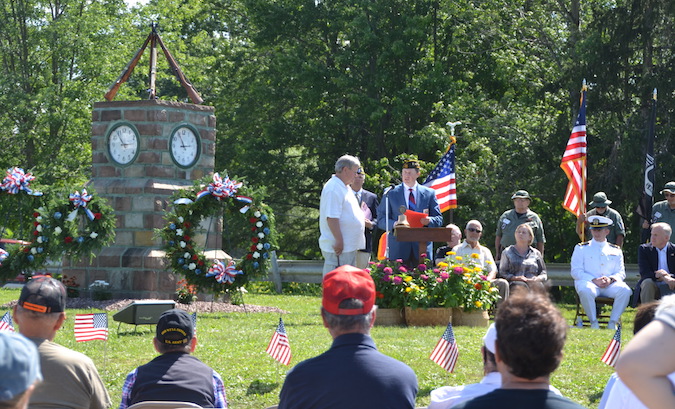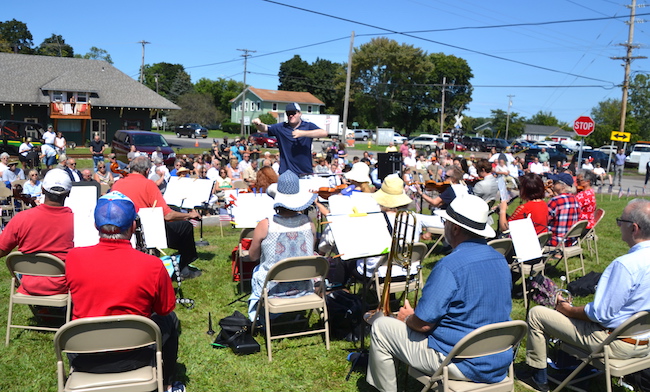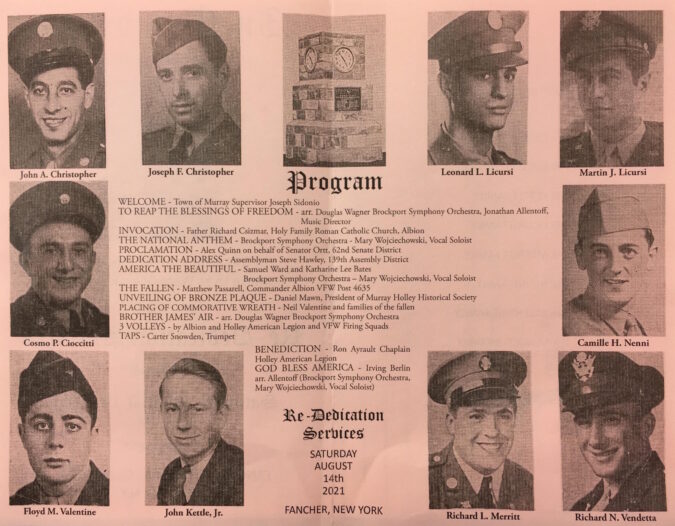‘Boys from Fancher’ included 2 sets of brothers, 3 who remain MIA
By Matthew Passarell, Commander Albion VFW Post 4635
(Editor’s Note: Passarell researched the 10 men honored with the memorial in Fancher and delivered these remarks Saturday during the rededication of the monument.)
Good afternoon ladies and gentlemen. We would be remiss in our responsibilities today if we left this Memorial without having some idea of what these men endured. Men who, at an average age of 24, gave their lives so that we might be free.
These are the boys from Fancher.
John A. Christopher – Army Air Forces (1919-1943)
Enlisted November 1942 and later served with the 853rd Aviation Engineer Battalion. Private First Class Christopher died on November 26, 1943 when the transport ship carrying his unit was struck by a German radio controlled glider bomb and sunk off the coast of Algeria. This attack remains the largest loss of military personnel at sea in a single incident in United States history. John A. Christopher was laid to rest at the North Africa American Cemetery in Tunis, Tunisia.
Joseph F. Christopher – Army Air Forces (1917-1943)
Entered service January 4, 1942 and later assigned as a B-24 radio operator with the 512th Bomb Squadron, 376th Bomb Group. Technical Sergeant Christopher served in the North African campaign. He was reported as missing in action on April 28, 1943 after his plane crashed in the harbor at Naples, Italy. Joseph F. Christopher is memorialized on the Tablets of the Missing at North Africa American Cemetery in Tunis, Tunisia.
Cosmo P. Coccitti – Army (1922-1944)
Enlisted September 26, 1942 and was assigned to the 17th Cavalry Reconnaissance Squadron. During fighting in Holland on November 10, 1944 he was declared missing in action and to date his remains have not been recovered. Technician Fifth Grade Coccitti is memorialized on the Tablets of the Missing at the Netherlands American Cemetery in Margraten.
John Kettle, Jr. – Army (1920-1944)
After working at the Curtiss-Wright Aircraft Corporation in Buffalo and Columbus, Ohio, John Kettle Jr. entered the Army on March 4, 1944. By October that year he was serving as an infantryman with C Company, 317th Infantry Regiment, 80th Infantry Division attached to General George Patton’s Third Army Private Kettle was killed in action near Farebersville, France on November 29, 1944 and is buried at Mount Albion Cemetery.

Matt Passarell (center at podium), VFW commander, researched the 10 soldiers and shared about them on Saturday. After he read about each soldier, Dan Mawn, left, rang the bell in recognition of the life.
Leonard L. Licursi – Army Air Forces (1922-1944)
A ball turret gunner with the 652nd Bomb Squadron, 25th Bomb Group. Staff Sergeant Licursi was one of five airmen killed when his B-17 Flying Fortress crashed after taking off from Watton, Norfolk, England on September 6, 1944. His aircraft was flying that day on a weather reconnaissance mission. Leonard Licursi is buried at Holy Cross Cemetery, Holley.
Martin J. Licursi – Army Air Forces (1919-1945)
First Lieutenant Licursi served as a navigator based in Chelveston, England with the 8th Air Force’s 364th Bomb Squadron, 305th Bomb Group. In September 1943 Lieutenant Licursi survived an emergency landing of a B-17 Flying Fortress in the English Channel. However, on February 15, 1945 he was killed when the B-29 Superfortress he was aboard crashed on a training flight in Flushing Bay, Queens, New York. He was laid to rest at Holy Cross Cemetery, Holley.
Richard L. Merritt – Army (-1944)
Served with the 3483rd Ordnance Maintenance Company in the Philippines. On November 12, 1944, the ship carrying his unit anchored off Leyte was bombed by Japanese aircraft resulting in casualties to three-quarters of his unit. Technician Fourth Grade Richard L. Merritt died the following day, November 13, 1944 and was buried at the Manila American Cemetery, Fort Bonifacio, The Philippines.
Camille H. Nenni – Army (1919-1945)
Entered service in October 1940 as a member of Company F, 108th Infantry Regiment, New York Army National Guard. He was transferred to the 40th Infantry Division and served in the South Pacific Area. Private First Class Nenni was killed in action on February 15, 1945 during the Luzon Campaign in the Philippines. He was awarded the Silver Star posthumously for conspicuous gallantry in action and laid to rest at St. Joseph’s Cemetery, Albion.
Floyd M. Valentine – Army Air Forces (1921-1945)
Enlisted September 7, 1942 and served as a gunner on an A-20 Havoc with the 675th Bomb Squadron, 417th Bomb Group. Staff Sergeant Valentine was awarded the Air Medal for flight missions over Japanese targets in New Guinea and Indonesia. On January 2, 1945 his aircraft was damaged while attacking enemy shipping near San Fernando Point, The Philippines and he was reported as missing in action. To date, his remains have not been recovered and he is memorialized at the Walls of the Missing at the Manila American Cemetery, Fort Bonifacio, The Philippines.
Richard N. Vendetta – Army Air Forces (1921-1944)
Earned his flight wings upon completing the Navigation School at San Marcos, TX on January 15, 1944. Assigned to duty on a bomber in the Troop Carrying Command, Second Lieutenant Vendetta was killed when another plane collided with his over Stanford, England on July 8, 1944. He was buried at St. Joseph’s Cemetery, Albion.
These are the boys from Fancher.
- Two sets of brothers.
- Two buried in overseas cemeteries.
- Three who remain missing in action.
- Five men who made the final trip home.
These men, as the poet John Gillespie Magee Jr. once wrote, “have slipped the surly bonds of Earth and danced the skies on laughter silvered wings.”
Thank you.

Jonathan Allentoff directs the Brockport Symphony Orchestra during Saturday’s ceremony. About 200 people attended the event.










































































